Stalybridge War Memorial
Stalybridge War Memorial
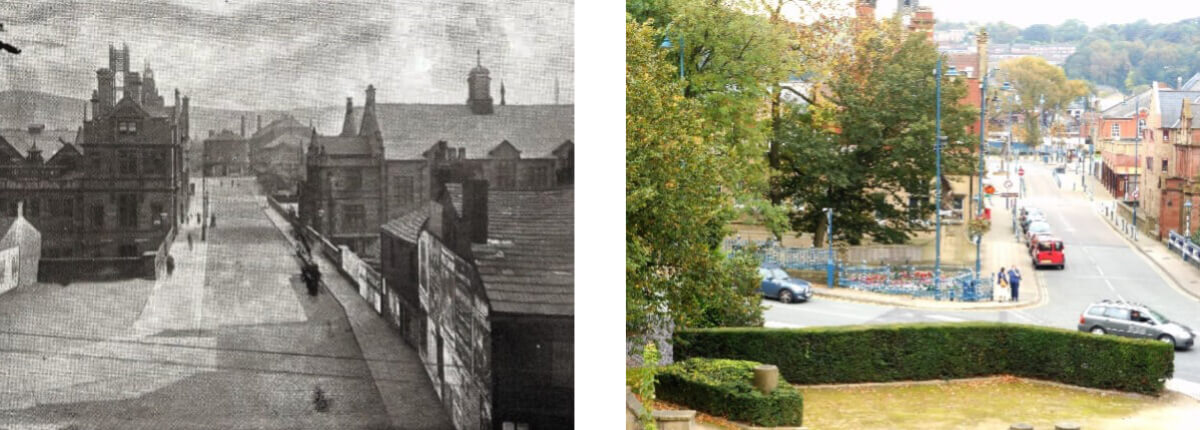
Trinity Street, Stalybridge
In 1919 it was decided to erect a War Memorial in Stalybridge at an estimated cost of £4,200. Within a few weeks following a public appeal £6,000 was raised. Subsequently, the surplus money was generally devoted to the education of the children of those killed in the war. The design and sculpture of the Memorial was by an eminent London sculptor and native of Stalybridge, Frederick Victor Blundstone. The lettering and construction were both undertaken by Messrs William Kirkpatrick and Company Limited of Trafford Park, Manchester.
The Stalybridge War Memorial is situated at the Northern end of Trinity Street, at the point where it meets Market Street. When it was built it faced the Stalybridge Town Hall, but this has since been demolished. The initial Memorial was bisected by Trinity Street and it backs onto Victoria Bridge which spans the River Tame. The Memorial was inaugurated on November 6th, 1921 and approximately 24,000 people, virtually all the population of the town, attended the ceremony. The Great War tablets initially bore the names of 628 men from Stalybridge who lost their lives in World War 1, but with later additions the final figure was 666. Recent research has identified approximately 300 names connected with Stalybridge whose names are missing from the memorial.
The memorial takes the form of a picturesque bridgehead, in the shape of an ellipse, half on one side of Trinity Street and the other half on the opposite side. On both sides of the road between the two ellipses there are two pedestals each 10 feet (3.05m) high, and each pedestal bears an 8 foot high (2.62m) bronze figure. The original memorial measured 110 feet (33.53m) from wing to wing. The wing walls are 5 feet (1.52m) high and terminate at secondary pedestals topped by crouching lions. The names of the fallen are carved on polished granite and the base of the memorial is finished with a border of fluorite spar, 2 feet (0.73m) in width, with a low kerb to enable the propping up of wreaths.
From the left the pedestal bears a crouching lion and the words:
FRANCE
PALESTINE
MESOPOTAMIA
EGYPT
E. AFRICA
The wing wall then leads to the Navy pedestal, which is topped by an angel ministering to a dying sailor whose cap bears the name of Good Hope. The pedestal bears the town of Staybridge’s coat of arms in stone and on the pedestal is written:
1914 1918
JUTLAND
ZEEBRUGGE
THE FALKLAND ISLE
REMEMBER THE LOVE OF THEM WHO
CAME NOT HOME FROM THE WAR
SEE YOU TO IT THAT THEY SHALL
NOT HAVE DIED IN VAIN.
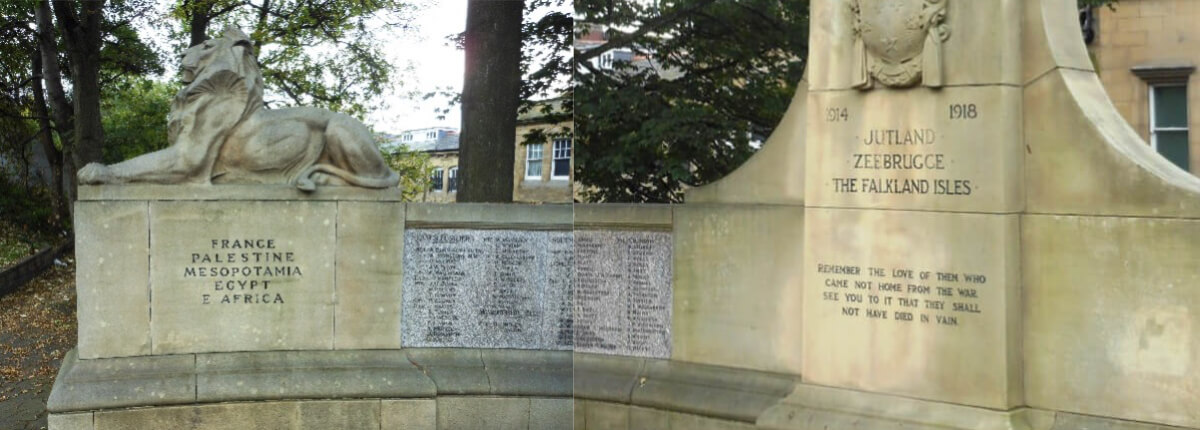
On the other side of Trinity Street is the army pedestal, topped by an angel ministering to a dying soldier. It also bears the town of Staybridge’s coat of arms in stone, and on the pedestal is written:
1914 1918
THE MARNE
YPRES
THE SOMME
ALL YOU WHO PASS BY
REMEMBER WITH GRATITUDE
THE MEN OF STALYBRIDGE
WHO DIED FOR YOU
There was a second crouching lion topping the remaining pedestal, but when the World War II section was added it was re-positioned at the far end of the memorial. bearing the words:
FLANDERS
GALLIPOLI
SALONIKA
ITALY
S. W. AFRICA.
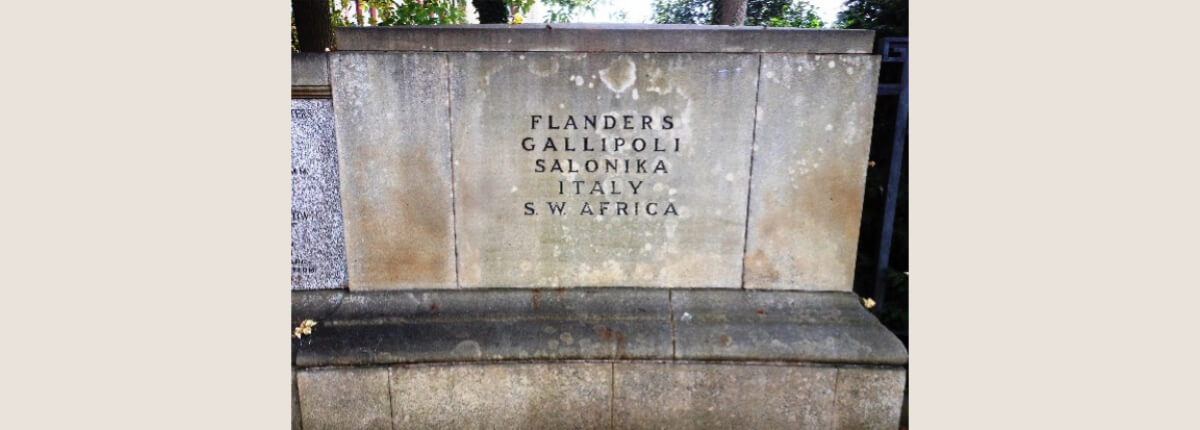
A ceremony of dedication began at 3 o’clock. The Mayor of Stalybridge, Councillor Mrs. Ada Summers, unveiled the Army pedestal, and Alderman James Bottomley, the town’s Mayor during the war, unveiled the Navy pedestal. Ex-Private Ernest Sykes V.C. of Mossley, but of a Stalybridge family, laid a wreath on behalf of the Stalybridge Branch of the British Legion of Ex-Servicemen. The memorial was dedicated by the Rural Dean of Mottram, Canon T. H. Sheriff. A choir of 400 voices from all the town’s churches was present, and after the ceremony the memorial was covered with flowers. (1)
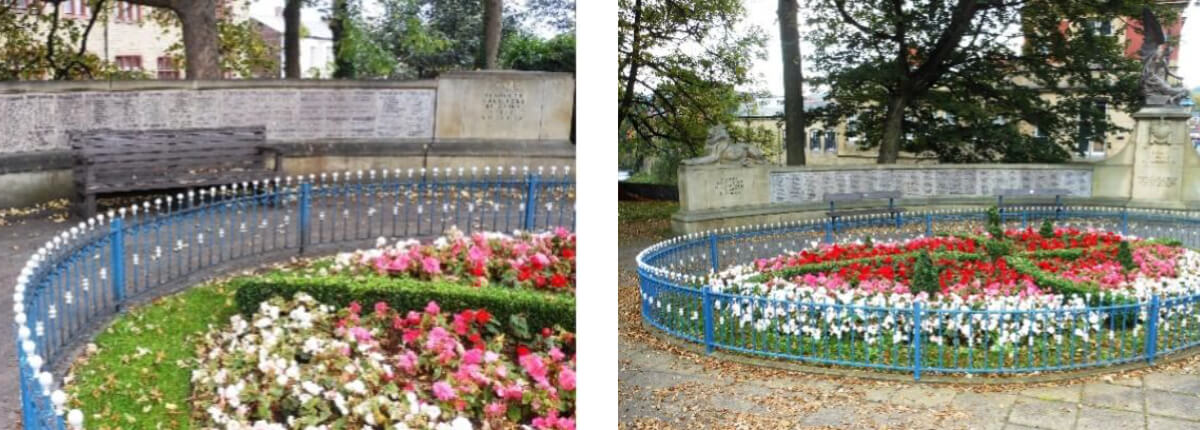
Stalybridge War Memorial - World War II
The Stalybridge World War II memorial was unveiled on April 23rd, 1950 in front of a crowd of between 3,000 to 4,000 people. It cost £2,400 and is linked to the existing memorial by means of bronze railings which stand in front of what used to be a small garden of remembrance, adding a touch of colour to the white sameness of the curving masonry.
The World War II section bears the nmes of 127 men from Stalybridge who lost their lives in World War II, but the ongoing research into the memorial has located approximately 25 soldiers who have died and are connected with Stalybridge whose names are missing from the memorial.
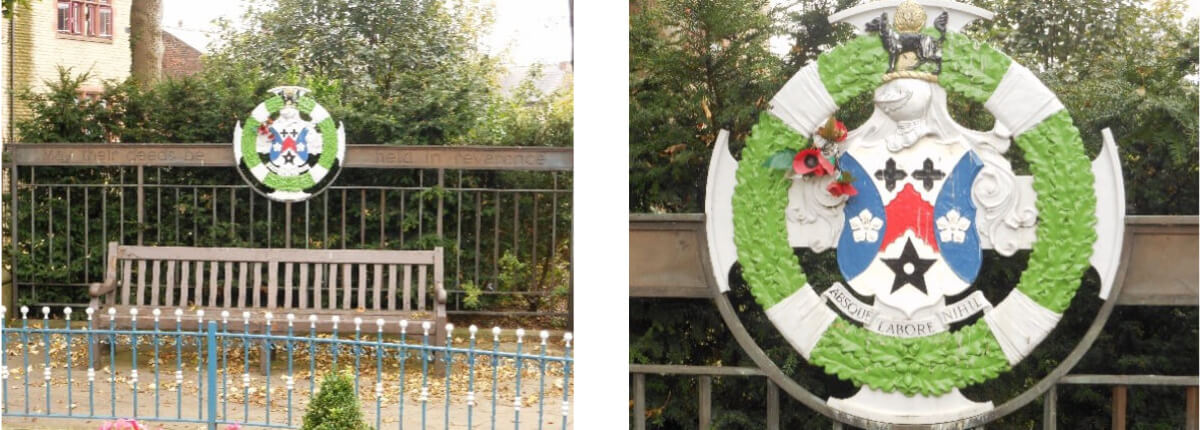
The railings bear the town's coat of arms and the inscription:
MAY THEIR DEEDS BE HELD IN REVERENCE.
To the right of the railings is a tablet bearing the inscription:
1939 - 1945
ON LAND, ON SEA, AND IN THE AIR.
AT HOME AND ABROAD.
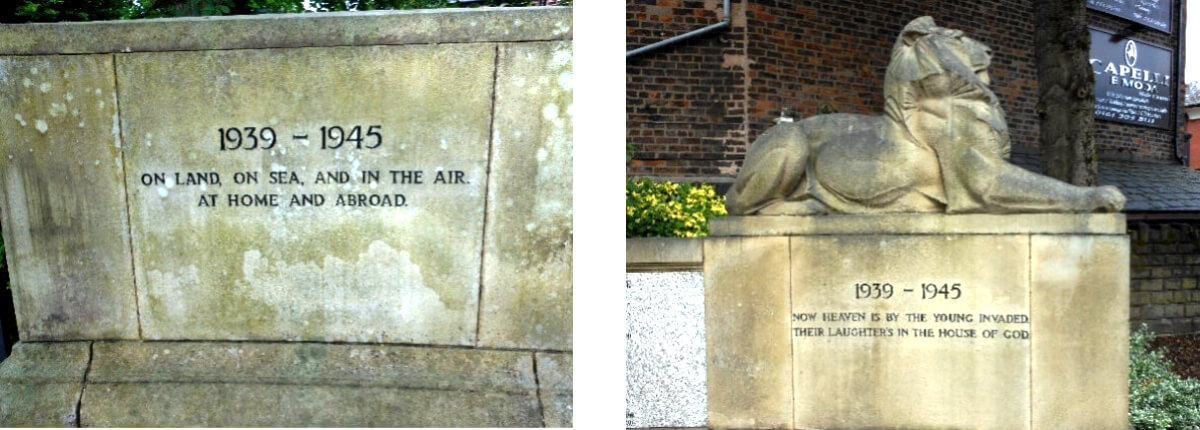
Further to the right is the right-hand lion crouching, which has been relocated from its original place at the end of the World War I Memorial, to now terminate the complete Stalybridge War Memorial as a whole.
Written on the pedestal are the words:
1939 - 1945
NOW HEAVEN IS BY THE YOUNG INVADED
THEIR LAUGHTER’S IN THE HOUSE OF GOD.
These words are taken from Katherine Tynan’s poem 'Flower of Youth'.
The extension was unveiled by Mrs Gertrude Monday of 128, Mottram Road, a lady who had lost her husband in the Great War, and her son in the second war. Alderman L. Harris, the Mayor laid the first wreath, followed by Lord Leverhulme, the lord lieutenant of Cheshire. Prayers of thanksgiving and dedication were led by the mayor’s chaplain, the Rev. John Winn.
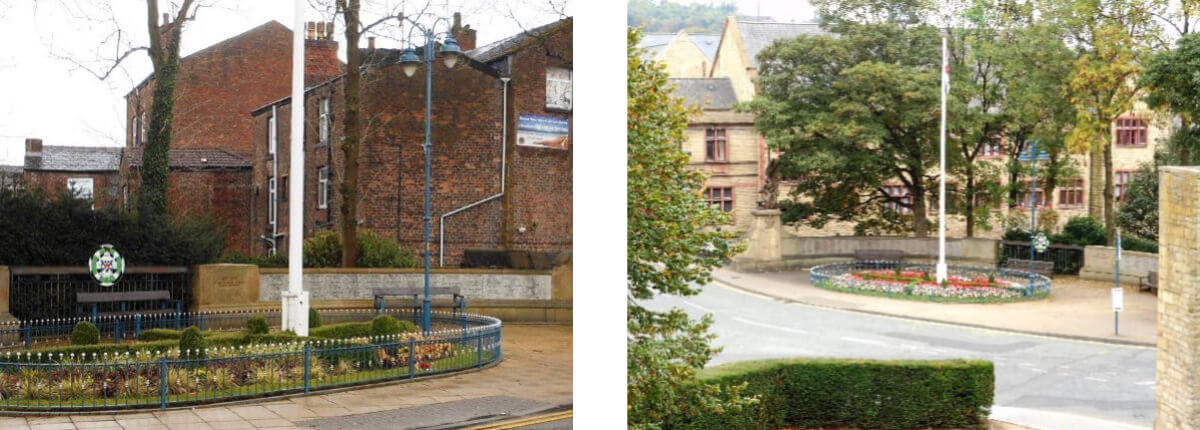
Stalybridge War Memorial - World War I (part) and World War II
More than nine million men and women are estimated to have served in the British armed forces during the First World War. Many of the surviving service records from this period can be found in The National Archives, and these records can be used for tracing an ancestor who fought in the Great War.
When war broke out in August 1914, the British army numbered just over 730,000 men. Unlike the other major European states, where conscription allowed huge numbers of men to be rapidly brought under arms, Britain relied on a small, professional defence force. But the scale of the conflict between the Allies and the Central Power demanded massive increases in Britain’s military manpower resources. By the end of the war in 1918, more than seven million men and women had seen service in the British army.
Unfortunately, more than half of their service records were destroyed in September 1940, when a German bombing raid struck the War Office in Arnside Street, London. However, an estimated 2.8 million service records survived the bombing or were reconstructed from records from the Ministry of Pensions. This means that there is roughly a 40% chance of finding the service record of a soldier who was discharged at some time between 1914 and 1920. (2) So, the information that would have been available from these records in some cases is very basic.
In addition to the men listed on the memorial, research by Kate Booth of Millbrook has revealed approximately another 300 names of men connected with Stalybridge within her book ‘The Missing Men of Stalybridge’, that have not been commemorated on the War Memorial. It is planned to add these missing names within the area of the Memorial, on a new extension, also allotting space for the inclusion of names from more recent conflicts with monies being raised for the project from public donation.
For recognition purpose all the soldiers from Stalybridge, have been included, including all the presumed missing individuals. This now totals 666 names already listed on the memorial, and 299 names that are missing from the Stalybridge World War I Memorial, and the 127 names that are already listed on the Stalybridge World War II Memorial and 25 names that have been found to be missing from the memorial which is a varying figure as more are discovered.
The 965 men from World War I were spread out, in around 83 Regiments and several Unknown Units. 53 of them from the Lancashire Fusiliers. The furthest away enlistments were 1 in Liverpool, New South Wales, Australia, and 6 enlistments from Canada.
The Soldiers who made the ultimate sacrifice are recorded on the War Memorial as having connections with Stalybridge. There are worldwide cemeteries and memorials to all our comrades who made the ultimate sacrifice in World War I, but with thanks to the Commonwealth War Graves Commission and the various foreign Countries, where the conflicts took place, these soldiers are still commemorated.
The memorials have been erected to commemorate the soldiers who were never found and as such have no known grave. In just France and Belgium there are over 960 cemeteries and memorials. Our lads from Stalybridge are buried or commemorated in approximately 316 of these. Listed as follows, Belgium 64, (224 Casualties), Egypt 1, (5 Casualties), England, 22, (82 Casualties), France 189, (489 Casualties), Germany 3, (6 Casualties), Greece 7, (15 Casualties), Israel and Palestine 5, (10 Casualties), India 1, (1 Casualty), Iran 1, (1 Casualty), Iraq 2, (27 Casualties), Isle of Wight 1, (1 Casualty), Italy 5, (6 Casualties), Pakistan 1, (1 Casualty), Turkey 4, 28 Casualties), Wales 1, (1 Casualty), and 64 further casualties who at the moment their final resting cannot be found.
(1) https://www.tameside.gov.uk/warmemorial/stalybridge
(2) https://www.nationalarchives.gov.uk/pathways/firstworldwar/service_records/sr_soldiers.htm
- Hits: 2176